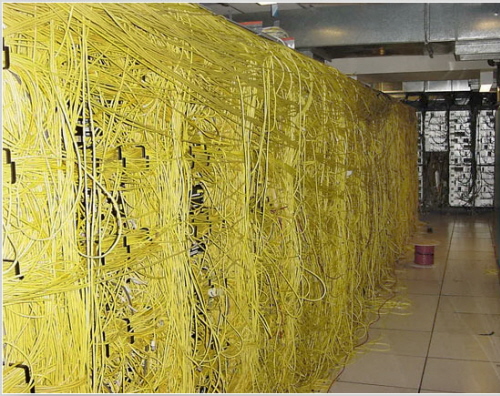Patch Panels.
- Thread starter C&GStudent
- Start date
Sponsored Links
I thought the problem was that (visually) they aren't at all quite different - the RJ-45 8P2C looking virtually identical to the 8P8C used on the ends of twisted-pair network cables?these are not RJ-45 sockets. RJ-45 is something quite different.
I thought yellow cables were reserved for crossovers?
We use pink cables for crossovers at work
For everything else we are now moving to http://www.patchsee.com cables. There is a plastic fibre optic cable running down the patch cable, and a special tool allows you to shine a light from either end which identifies the other end. Then no matter how spaghetti like the patching becomes you can always identify the cables.
Sponsored Links
P
Paul_C
I thought the problem was that (visually) they aren't at all quite different - the RJ-45 8P2C looking virtually identical to the 8P8C used on the ends of twisted-pair network cables?
They are very similar in appearance, but an RJ-45 jack has a keyway on one side, and uses a corresponding keyed plug. A true RJ-45 plug, therefore, won't actually fit into the unkeyed 8P8C jacks used for computer network connections - Not that you would want it to!
But the point which many people don't seem to understand is that the RJ (Registered Jack) numbers refer not only to the physical type of plug & jack used, but also to the specific wiring configuration. The designation thus refers to the combination of jack type and the way in which that jack is wired. The same 6-position jack, for example, can be RJ-11, RJ-14, or RJ-25, depending upon whether it's wired for one, two, or three telephone lines respectively.
RJ-45 is the designation for a modem connection using an 8-position keyed jack, with one pair used for the line and a second pair used for a programming resistor to set the transmit level of the data equipment. It's pretty much obsolete now, and was never adopted officially in the U.K. anyway.
I see your doors have pictures of neat cables painted on them.
Very cunning trick
Especially when you consider that those aren't equipment racks, they're beer coolers!!!
I thought yellow cables were reserved for crossovers?
No, that's just the colour Belkin, your local excessively overpriced high-street brand of junk, like to use.
No, goes back to my PO 316 jackfield days ...
I thought yellow cables were reserved for crossovers?
No, that's just the colour Belkin, your local excessively overpriced high-street brand of junk, like to use.
No, goes back to my PO 316 jackfield days ...
And what do telephone and audio patchbays have to do with ethernet?
And again, I think you'll find it's entirely arbitrary, not standardised in any way.
It might say - I can't remember
where the hell is that lot in use?
St. Louis, Missouri. apparently
http://royal.pingdom.com/2008/01/09/the-worst-cable-mess-ever/
DIYnot Local
Staff member
If you need to find a tradesperson to get your job done, please try our local search below, or if you are doing it yourself you can find suppliers local to you.
Select the supplier or trade you require, enter your location to begin your search.
Please select a service and enter a location to continue...
Are you a trade or supplier? You can create your listing free at DIYnot Local
Sponsored Links
Similar threads
- Replies
- 90
- Views
- 37K
- Replies
- 13
- Views
- 2K
- Replies
- 14
- Views
- 2K




